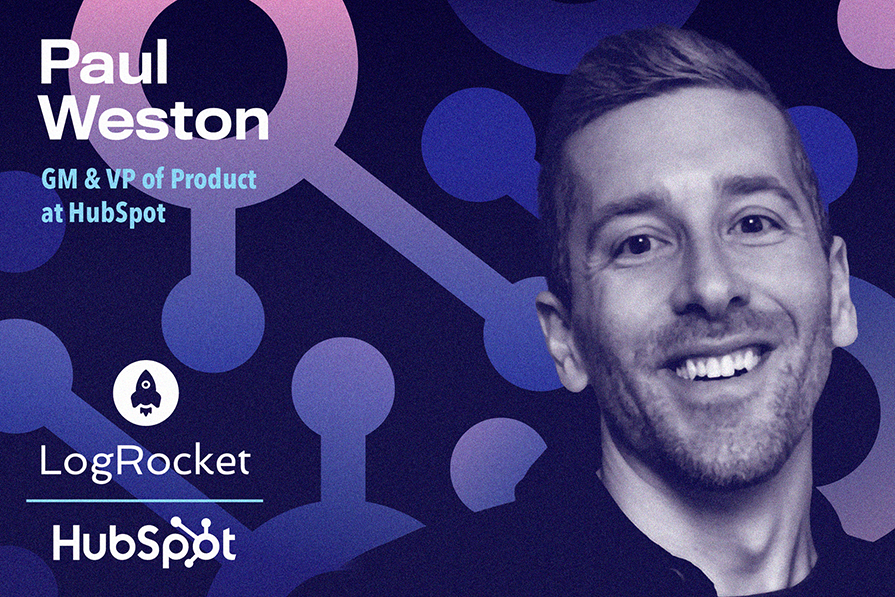Paul Weston is a GM & VP of Product at HubSpot where he oversees the product vision and strategy for the Service Hub product line. In his eight years at HubSpot, he has managed and overseen various products, including teams in Marketing Hub, Operations Hub, and now Service Hub. Prior to HubSpot, Paul has held various product management roles at Constant Contact and startups.

In our conversation, Paul talks about “quantifying the unquantifiable,” i.e., bringing in objective data for things that otherwise seem hard to measure. He discusses the value of focusing on one set of customers and prioritizing their needs. Paul also shares how he thinks about product differentiation and strategy.
As GM & VP of Product at HubSpot, what is your process for evaluating different potential UX experiences?
Let’s go back to basics! I start by thinking about the job of a product manager, which is to maximize customer and business value. PMs can sometimes get lost in day-to-day responsibilities of writing PRDs and managing backlogs or stakeholders. It’s easy to lose sight of the forest for the trees. We have to remind ourselves of the outcomes that we’re here to produce, and hold ourselves accountable to those measurements.
PMs intuitively know that they should be outcome-oriented. No one’s going to disagree with that. But there are times when it’s really hard or unclear how to measure success.
I’ve seen this many times, especially with UX-heavy initiatives. It’s intimidating for some PMs to work with UX, or to constructively collaborate when you’re not a designer. You can’t just go off vibes or intuition, and you have to provide the structure and environment to measure progress. That’s the only way you’ll know if your team’s investment is paying off in terms of customer or business value. This is where we get into quantifying the unquantifiable.
Let’s take an example — editors for creating emails or web pages. This is something I’ve come across several times in my journey at companies like Constant Contact and HubSpot. Editing experiences are very nuanced with lots of micro-interactions. When I drag an image from the side panel and bring it into the document, how does the text in the document react? How do users expect to resize an image, via a side-panel or by dragging image corners? Questions like this can go on and on. There are many UX models to choose from, and it’s hard to say which one’s best.
As a PM, again, your responsibility is to maximize customer value. Constructing a great user experience can be a major investment, and if you choose the wrong interaction pattern it can result in weeks or months of wasted effort. This underscores the importance of bringing in objective, quantifiable data. But how do you do that when you’re talking about ambiguous design concepts, especially when static mock-ups are insufficient?
The first thing we do is talk to customers and get early reactions to either prototypes or existing tools that showcase various patterns you’re considering. I’ve had a lot of luck comparing interactions from products that already exist — even ones that aren’t direct competitors or in the same industry (e.g., Google Docs or Canva). By researching tools with interactions that are already functional, you can save countless hours to get directional feedback. But the real unlock for us in this case was with unmoderated user testing. We would set up prompts and tasks for users to attempt, using different prototypes or functional software with UX patterns we wanted to test.
We were able to see their time-on-task, first click, and satisfaction scores for individual tasks. We uncovered a lot of things that may have been glossed over or completely missed. These are things that may initially seem hard to measure, but are actually very quantifiable. It also helped us move faster.
At the end of this effort, we had a map of the various UX patterns that our team had been debating. But instead of debates based on intuition, we could definitively see which pattern works best for each task. For example, “This pattern is best for resizing images, that pattern is best for drag and drop, and this is the best pattern for editing text.” And finally, we built our own UX model of what the best experiences were based on that mosaic of data. This entire effort took about a week to run, end-to-end, and gave us a ton of confidence in terms of product direction. It also potentially saved months of wasted effort.
Yes! As humans, we all have preconceived notions or biases of what’s best. It was surprising to see name brands that everyone knows fall short during unmoderated user testing. We would look at patterns of these various editors that we saw as the “best in class.” There were tasks that customers would really struggle with in these name brands, and it was really interesting to see. Certain companies have halo effects, so we assume that their way of doing things must be the best. “If this leading brand is doing it, it must be the way,” but that’s not always the case.
This is a good reminder to focus on the customer, put examples in front of them, and let them decide, both with their words and with their actions. After implementing our UX patterns based on this research, our teams saw amazing results. My favorite was a 300 percent improvement in email publish rate because of improvements to the editing experience.
The most successful product teams pick a lane. When you do that, you by definition have to de-prioritize certain sets of customers, and that’s OK. The intuition of a product manager is often to say “yes” to customers. We all want to make customers happy. But sometimes, product strategy is about saying “no” and making difficult choices. Product strategy is about focus, and making the cohort of your target customers super happy. That’s not to say other cohorts can’t also love your product, but it provides focus and purpose to prioritization and quantification of success. Sometimes you have to say “no” to good, to say “yes” to great.
My role at HubSpot is leading our Service Hub product line, which is responsible for customer support and customer success teams. We’re able to focus exclusively on solving for CSMs, support reps, and their operations teams. There are a bunch of things we’ve done to whittle that down further, including total addressable marketing (TAM) analysis for various adjacent support and success categories.
We’ve also done a lot of firmographic and industry analysis — HubSpot serves a lot of software companies, for example. In the end, our focus is on B2B companies, primarily in the software space, with up to 2,000 employees. We’ve also built a sharp perspective on personas, archetypes, and their jobs-to-be-done based on in-depth customer research. All of this helps to inform our product strategy and prioritization decisions.
At HubSpot, we’ve been accelerating and heavily investing in AI initiatives. We started like a lot of other companies, building features like AI summaries or text generation. But over time we’ve hit our stride in terms of AI features that deliver real outcomes. From “neat” to “necessary.” Now, we’ve got outcome-oriented AI in the form of a Prospecting Agent, a Knowledge Base Agent, a Content Agent, and a Customer Agent that can resolve more than 50 percent of support tickets.
Customer Agent has been incredibly successful, and I attribute a lot of the success here to focus. For support use cases with Customer Agent, we maniacally focused on the resolution rate as our North Star and that was a game changer. We went from a 15 percent resolution rate to higher than 50 percent in less than a year, with some customers resolving up to 90 percent of their tickets. As we built the roadmap, we constantly asked ourselves, “Will this feature help resolve more customer issues and improve the quality of responses?” If the answer was no, we deprioritized. It’s really easy to get distracted by competitors or new shiny AI capabilities, but our North Star gave us focus and drove real outcomes.
When you’re first starting off a project, there’s more ambiguity and a sea of many different things you can measure. We decided to stick to that one specific measurement, and it became our North Star. It’s been a really fun, fulfilling journey seeing customers drive real results with AI.
When I first joined Service Hub in 2022, we interviewed hundreds of customers and prospects. We’d interview post-sales leaders that oversee a variety of roles like implementation specialists, customer support, and customer success teams. We’d ask, “What does success mean to you? How do you measure your own success as a leader in this department?” Repeatedly, they would say customer retention and growth. That was a lightbulb moment for us. All of these sub-departments ladder up to the ultimate goal of customer retention and growth.
There is a “red ocean” of companies competing on help desk or customer success as point solutions. But nobody is solving holistically for the end customer or for the leader of the post-sales department. There are tools in the market for each of these sub-departments, but nothing that ties them all together. Unified data became our “blue ocean” strategy as we solve specifically for the outcomes that our customers care about.
HubSpot is well-known as a marketing automation platform and world-class CRM. Service Hub was initially created to “finish the flywheel” for HubSpot, to go from visitors to leads to deals to happy customers. But we learned that it was hard to talk strictly about “tickets” when many of our customers cared about “leads” and “deals,” it was kind of a non-sequitor. With our focus on helping drive customer retention and growth (across customer support and customer success), Service Hub fits more naturally into the conversation.
We learned that the value prop needs to be very organic and natural in the flow of conversation for our largest customer cohorts, which are in revenue-generating roles. That can be hard to do with traditional support software, but this is the beauty of focusing on retention and growth. We like to say that customers are often your best source of prospects. They’re also often your best marketing channel as promoters, especially in this day and age, where traditional marketing activities like SEO are at risk with AI.
It all goes back to what post-sales leaders care about. Why are they buying software in the first place? They’re buying it to help retain and grow their customer base. We always bring it back to that. We think the best way to do that is through a unified customer platform. When you have your data in one place, you don’t have the deduplication problem, data integrity issues, problems with syncing, etc. It’s all natively in there.
All of your unstructured data from calls, meetings, and emails is super valuable in terms of making customers more successful. Understanding customers’ goals and motivations and aligning support personnel to those accordingly is critical. For example, if a customer is clearly frustrated, you might want to handle that case a little bit differently or even escalate to a specialist with skills or training to handle the issue. There are a lot of ways that this data can come together and inform support, which is very unique.
Plus, when you have all this data together, operations people breathe a sigh of relief. They don’t have to manage a dozen different systems with different authentication and integration issues. It’s a maintenance and cost burden, and we’re solving that. You also don’t have to relearn different software. All the patterns are the same, all in one place.
And unified data doesn’t just help to retain and support customers, all of that rich customer data also helps to provide more targeted, personalized marketing and effective, efficient sales too.
There’s a question of breadth and depth. I mentioned earlier that product strategy is often saying no, which is really important. You need to have a clear idea of all missions and where to draw your lines.
For us, we’re very happy focusing on customer success and customer support. There’s enough there to keep us busy for a long time. Our goal is to create the easiest, fastest, and most unified product for post-sales teams. The differentiation is all about making that “unified data” story even more seamless. We’ll present users with data they didn’t know they had, even when they didn’t know they needed it. Those are the real differentiation moments because that customer platform perspective is hard to replicate.
For other companies that want to turn a red ocean into a blue ocean, I suggest that you always go back to first principles. What do your buyers and users care about? How do they measure their own success? Why are they employing your software? People just don’t buy software just for fun — they do it because they think that it’ll make them more efficient or better at achieving certain outcomes. If you deeply understand those aspects and you orient your product and measurements around those principles, you can’t go wrong.
LogRocket identifies friction points in the user experience so you can make informed decisions about product and design changes that must happen to hit your goals.
With LogRocket, you can understand the scope of the issues affecting your product and prioritize the changes that need to be made. LogRocket simplifies workflows by allowing Engineering, Product, UX, and Design teams to work from the same data as you, eliminating any confusion about what needs to be done.
Get your teams on the same page — try LogRocket today.
Want to get sent new PM Leadership Spotlights when they come out?

As AI reshapes product roles, learn how emotional intelligence, curiosity, and balance will define the next-gen tech product leader.”

Lars Rieger, Head of Product at Digistore24 DACH, talks about the importance of relationships in product management.

Jie Cheng talks about how she brought an ecommerce and digital mindset to various organizations, including Mondelēz and Conair.

Monetizing with ads isn’t plug-and-play. Learn how AdTech really works so your product can generate sustainable, scalable revenue.